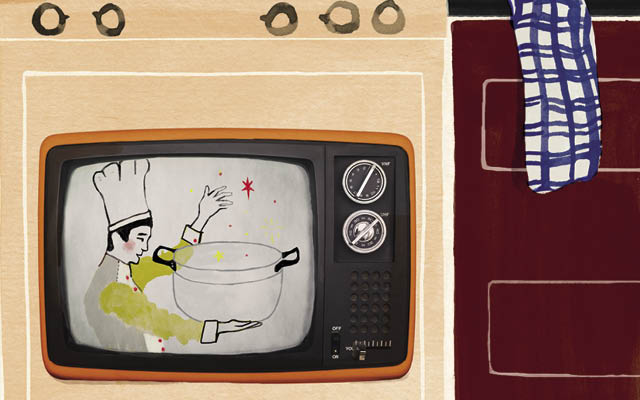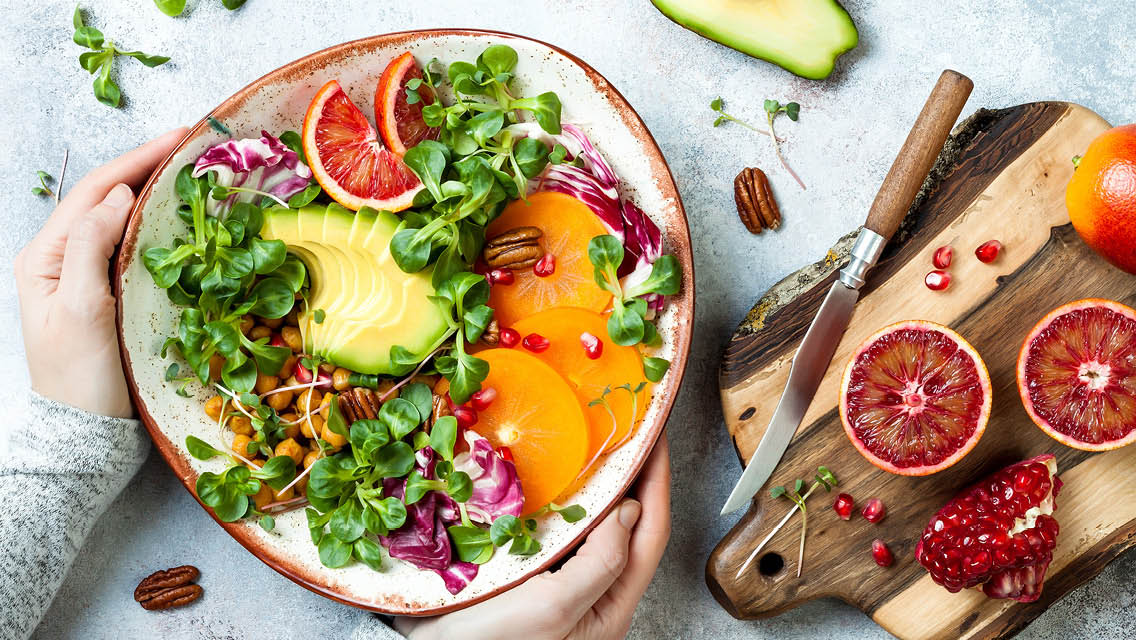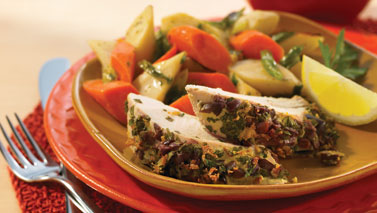In 1993 the Food Network was born, and it seemed like food television, bubbling on every American front burner, would be a part of our culture forever.
Yet, barely two decades later, Americans are watching fewer and fewer hours of TV, ad revenues are declining some 2 percent a year with no end in sight, and the New York Times reports that by 2020 nearly 50 million Americans will have jettisoned their televisions completely. This has left me wondering: What’s the future of our favorite kitchen appliance that doesn’t cook or preserve our food?
It’s also left me racking my memory banks, trying to recall the first food television I ever watched. I’m quite sure it was the Swedish Chef on The Muppet Show, singsonging his nonsense syllables and causing chaos in a nice 1970s wheat-colored kitchen, punctuating verses with his trademark “Bork, bork, bork!”
You didn’t need to know the iconic food TV of that era to recognize what the Swedish Chef was lampooning. He was spoofing our tendency to fetishize the superior culinary skills of other cultures — especially European — and our attempts to emulate their soothing, unchallenging cadence of cutting onions and stirring sauces. When the Swedish Chef threw spoons that exploded, it stood in hilarious contrast to the pleasant, sensible, and delicious-looking outcomes of every American cooking show. He himself stood in contrast to (but was also of a piece with) our first culinary TV star, the worldly and debonair James Beard, who debuted in 1946, as well as the loopy, authoritative, and snooty Julia Child, whose series first aired in 1963.
Perhaps because the Swedish Chef was my first television chef, I’ve always found food shows strange. There’s a quote attributed to various wits suggesting that writing about music is the same as dancing about architecture — an act of such mental impossibility that nearly everything sensible is lost in the effort. That’s how the basic (or even very good) instructional food shows have always struck me: Once you remove the real-world context of cooking, what’s left?
TV Food vs. Real Food
Grocery shopping in the real world defines much of an actual meal. A chef will change a menu because the market offers beautiful strawberries or decide on a dish featuring pork and prunes because it’s February and everything else is dismal.
Similarly, chopping ingredients is a huge part of meal preparation. That’s why those little glass bowls of perfectly diced peppers, finely minced garlic, and beautifully scissored herbs featured on cooking shows always drive me crazy. They give the illusion that an hour’s work somehow is done and cleaned away before you start if you’re really good at cooking.
When I met a former staffer from one of the popular cooking shows who swore that a certain famous cook employed a body double to do the bend-down-and-pull-the-tray-from-the-oven shots, I realized we had come to a silly point in the culture. This, of course, is to ignore the baldest and most obvious problem: The point of food is to eat it, smell it, touch it. What’s the difference between food on TV and no food at all? I mean, if you were starving — but also if you were not.
This phenomenon of food divorced from food certainly existed in the innocent times before Top Chef, MasterChef, and Chopped, which are basically game shows diced and tossed with soap operas masquerading as food TV. But I find these programs to be even less about food than the ones they replaced. When was the last time you were asked to dazzle a panel of haughty judges by creating, in one hour, a dish from a basket of cockles that just rose from a dry-ice cloud?
And I don’t even know where to begin with the screaming Gordon Ramsay. He reminds me less of a chef than of Punch in the Punch and Judy puppet show — a sort of Lord of Misrule who terrorizes the other puppets to teach them that life is terrifyingly unfair but also somehow funny.
The more I think about it, the less of a future I see for food TV and the more I long for the clarity of the Swedish Chef’s melodious but chaotic “Bork, bork, bork!”
A Digital Future
At a mental impasse, I phoned my friend Helen Rosner, who writes about food for the New Yorker and is always ready to dish opinions both strong and salty.
“What do you think the future of food television is?” I demanded, catching her as she climbed into a cab.
“Netflix,” she answered happily. “I don’t know if you remember five or six years ago, but for millions of people, Facebook was not a website or part of the internet — it was the entire internet. It’s where news lived, where you found a restaurant reservation, where Facebook Messenger was more important than email. For some people, it was simply everything. In the same way, for a lot of people, Netflix has become the entirety of television.”
Food TV on Netflix, Rosner explained, has distilled and perfected various other sorts of cooking shows that already existed. Julia Child and James Beard imparted some wisdom while they made a chicken, but the Netflix series Chef’s Table turns the chefs they profile into philosopher kings of infinite sagacity.
Top Chef allows a certain amount of razzle-dazzle and high jinks in the process of making a chicken that people take very seriously, while the Netflix show Nailed It! — in which amateurs crack up while aping real bakers and creating the most difficult pastries on Earth — is nothing but razzle-dazzle and high jinks.
Meanwhile, everything instructional that Julia, Jacques Pépin, or other conventional TV chefs used to offer has been strained out and posted on YouTube. “Think about it: If you want to know how to make onion soup, you want to know how to make onion soup. You don’t want that packaged with four other things,” said Rosner.
“The way the internet has fragmented time and attention means that I go looking for the information I need, as opposed to waiting for it to come to me. And then, because of the nature of streaming, all the episodes of a Netflix show or a YouTube video live there simultaneously outside of time, as constant, perpetual exposure. They’re always new in some ways, always waiting to be discovered or rediscovered.”
Will those Netflix and YouTube viewers include people who like to make a big pot of lentil soup, filling the house with warm and wintry aromas, and then watch three minutes of the Swedish Chef before enjoying a real dinner with real people?
I hope so, because the more I think about food television, the more it seems to me that the Muppet character had it right — food TV really is ridiculous. Netflix and YouTube may televise tomatoes simultaneously and permanently, but it’s never going to be real food. Until some Star Trek technology changes that, all of us will be better off with a cutting board than a glowing screen.
This originally appeared as “TV Dinners” in the March 2019 print issue of Experience Life.




This Post Has 0 Comments